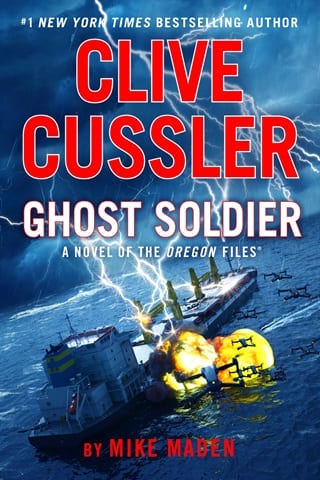Chapter 17
17
Aboard the Izanami
The Indian Ocean
The Vendor watched the articulating robot hand deftly insert the computer board inside the command module.
Originally developed for the video gaming industry, the board’s advanced microarchitecture and central processing units were built for machine learning. In fact, it was the gaming industry that had always pushed some of the most important advances in chip design for artificial intelligence. After all, they were chasing the incredibly lucrative market of dopamine addiction. Billions of people were hooked on first-person sport and shooter games, world-building fantasies, and simulated porn.
Bound by the inefficiencies of government waste, bureaucracy, and intervention, national defense industries had long lagged behind the free market free-for-all of billion-dollar gaming enterprises. But not all defense bureaucrats were morons. There was a decades-long relationship between the military industrial complex and video games involving transfers of talent and technology. Training, combat, and flight simulations, strategy games, and even virtual reality were all line items in national defense budgets. But it was the mighty computer chips the gaming industry was developing that powered it all.
Ironically, these same computing boards powering games of war were also driving the next generation of actual, blood-shedding war.
With the “brain” insertion of his Yari kamikaze drone complete, the automated assembly line moved the command module to the next level of drone construction. The Vendor’s management software had indicated that three of the four storage holds belowdecks were already full to capacity with Yaris stored in their quad-configured launch pods.
The Yari was his own variant of the infamous Russian Lancet drone, though his was far superior to the game-changing weapon. Cheaper than the average American car, the Yari was powered by a simple electric motor and capable of carrying a wide variety of mission-specific warheads. But the Yari’s true genius was its AI-driven ability to select its own targets for destruction as it loitered over the battlefield. With no need for ground or satellite communications, the Yari was also immune to anti-drone electronic countermeasures.
Additionally, the Vendor had built into the Yari a swarm capacity, allowing one drone to locate a target and instantly communicate with other Yaris on the ground or in the air in order to assemble a coordinated mass assault. Each four-winged drone was fitted with collapsible wings and loaded into a four-drone launcher. No taller than the average man, launchers could be placed on the ground, in the back of truck beds, on rooftops and shipping containers. A nearly infinite number of launchers and their Yaris could be linked and synced, and operated both manually and remotely.
The Yari was just one of several new weapon systems being developed and manufactured by his organization. No longer hampered by the petty bureaucratic politics and narrow-minded herd moralities of his former employers in the Japanese defense industry, the Vendor’s genius for destruction was finally unleashed when he disappeared mysteriously several years ago, secretly stealing petabytes of advanced weapons designs in the process.
Shunned by the lesser minds who governed him, the Vendor had long since abandoned primitive notions of patriotism. Stealing weapons secrets wasn’t an act of treason or even greed. The most important parts of those plans came from his own highly advanced mind, which meant they were his after all, despite the petty legalisms he’d agreed to early in his career when he was less confident and easily exploited.
Those stolen plans formed the basis for his first forays into private weapons manufacturing, which had proven wildly successful. The money came hot and fast and he quickly expanded his capabilities. His ultimate goal wasn’t greed but chaos—and the chance to prove his genius to the bureaucratic midwits that had rejected him.
Chaos was the key.
The Vendor viewed chaos as the prime virtue from which all others emerged. Even the gods couldn’t create the universe without chaos first being present. In turn, chaos birthed its angry progeny, crisis. These two ideas stalked humanity like tigers in the jungle. The greatest leaps in human invention came when chaos threatened human extinction. Without chaos, true genius was impossible.
Chaos was also the precursor to profits. The more chaos in the political order, the greater the need for machines of destruction. Defense budgets swelled; money flowed. The font of government-printed currencies continuously filled the Vendor’s coffers and funded his never-ending expansion.
That prodigious cash flow along with his legendary status in the international design community allowed the Vendor to build a clandestine network of current and former weapons designers from around the world.
He also built and operated a flotilla of ship-based automated manufacturing facilities along with a fleet of transportation vessels and aircraft.
This transportation network had become a surprising source of revenue. There was an insatiable demand for smuggling existing weapons stocks including the horde of American arms the Taliban now possessed.
His entire organization was under enormous pressure from his clamoring clients. The demand for his new and improved variants of the latest weapons systems was far outstripping his ability to supply them. He couldn’t build automated manufacturing vessels fast enough, though crewing them certainly wasn’t as much of a problem. The advantages of floating industrial complexes far out at sea and beyond the territorial jurisdictions of hostile governments were obvious, but there were also challenges—and not a few perils.
Just as the next quad launcher was being filled with its fourth Yari, the Vendor’s digital watch dinged on his wrist.
“Excellent,” he said to himself.
The third applicant for the “VIP security” assignment posted on the dark web had cleared his records check and accepted the job offer. Of course, none of the applicants would know that the true mission was a battle to the death with the Vendor’s new weapons systems on a remote island until it was too late.
The dark web advertisement promised a twenty-five percent upfront payment of an extravagant salary upon such acceptance. The Vendor tapped his watch and transferred Bitcoin into the applicant’s account. At this rate of recruitment, he would be traveling to the Island of Sorrows sooner than he planned.
 Fullepub
Fullepub 



